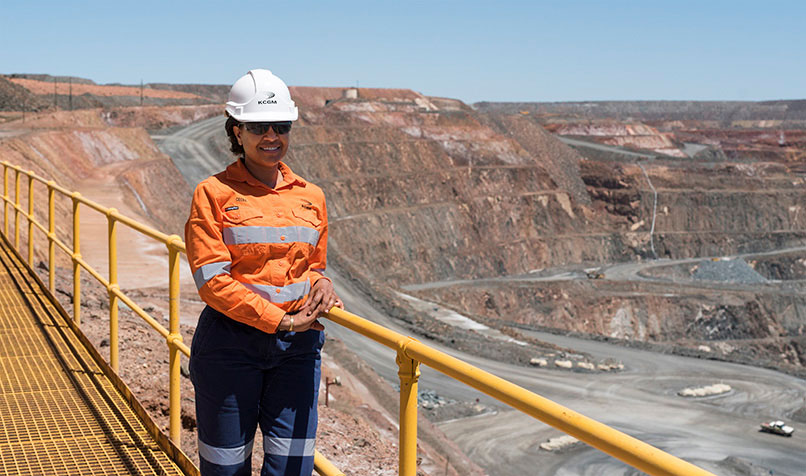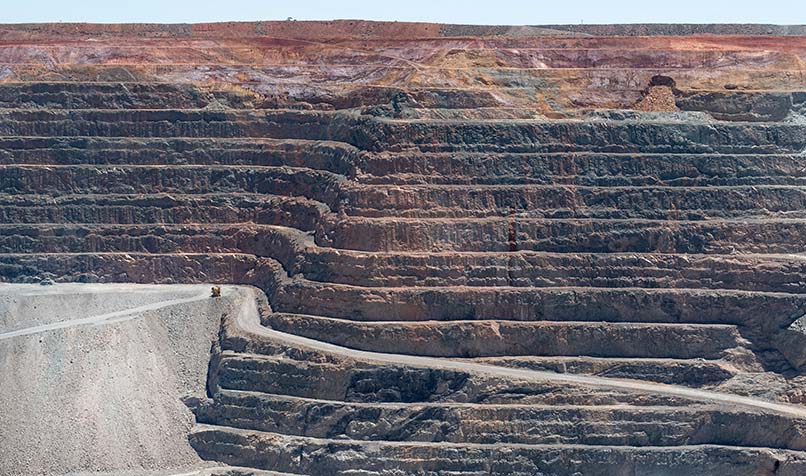Loading component...
At a glance
Cecile Thaxter is an old hand at breaking new ground. In September 2017, she became the first female general manager of Kalgoorlie Consolidated Gold Mines (KCGM), despite being a relative newcomer to mining operations. She spent much of her career as a strategist and an investment banker. Her first operational job came in 2014, when she was brought in to turn around Newmont Mining’s underperforming Phoenix/Lone Tree mine at Battle Mountain in Nevada in the US.
In less than four years, she cut operational costs by 10 per cent and boosted the mine’s normalised value by 20 per cent, delivering up to an extra US$40 million a year to the company.
Now, she has been tasked with managing Australia’s biggest open-pit goldmine at a critical time in its history, as the company works to extend the mine’s life. Open-cut mining at the Super Pit will conclude in 2021, and gold processing is expected to finish in around 2030.
From Jamaica to the Golden Mile

Despite her impressive CV, Thaxter’s background is very different to the stereotype of a corporate high flyer. She grew up in Port Antonio, a town on the north coast of Jamaica, one of five children in a nurturing but far-from-affluent family.
“I actually come from very humble beginnings, and maybe when I was growing up I didn’t realise how humble it was,” she says.
“I looked different from everyone, and probably still do. That made me very independent and, I guess, extremely accepting of diversity … so I’ve always been able to think outside the box.”
A brilliant student, books were her window onto the outside world. “My dad had this penchant for reading, and we grew up not having television, partly because we probably couldn’t afford it … So I grew up seeing the world through books.”
Yet it was still a culture shock when she was accepted by New York’s prestigious Columbia University, where some of the biggest lessons took place outside the classroom.
“The thing I really learned about was American culture and the importance of networking, speaking up and developing your brand.”
Those lessons were to prove invaluable when she took up roles as a senior associate with PwC and, later, as an executive director with investment bank UBS. There she was involved in a series of multibillion-dollar merger and acquisition deals, quickly gravitating towards the mining sector.
“I liked the sector because there was a lot of technology, it was quite complex, and the people that you meet in mining, they’re pretty down to earth and really good people to work with,” she says.
Ten years ago, she made the jump to the client side, joining Newmont Mining – first as a strategist, later as CFO for North America. Then in 2014 she was made general manager of the Phoenix/Lone Tree mine, fulfilling a long-held ambition to drive change from the ground up.
“The whole idea of being accountable for a P&L [profit and loss statement] always appealed to me,” she says.
“I had always wanted to do it, but didn’t know whether or not I would eventually get the opportunity – so when I did, I was pretty excited.”
She quickly realised the magnitude of the task ahead. “Two months after getting there, we had six injuries in six weeks … I saw very quickly I had to understand the culture and safety performance.”
“One of my favourite sayings is that you can’t lead somebody further than you’re willing to go …”
Over the next three years, she not only improved the mine’s financial results, she reduced injury rates by 75 per cent. Characteristically, she did so by combining painstaking data analysis with ongoing cultural change.
“Change for me is exciting – taking something, making it better. Trying to be that beacon of progress, if you will, and really shaping organisations and teams,” says Thaxter.
“I firmly believe in developing people, including developing myself. One of my favourite sayings is that you can’t lead somebody further than you’re willing to go – so that constant development of myself and learning more is really important to me.”
Breaking new ground for women in mining
As a woman of colour in companies largely managed by white men, Thaxter has reluctantly come to accept her role as a flagbearer for diversity in the workplace.
“There was a time in my career when I didn’t particularly like the fact that I was in focus just because of my gender. I was one of those who wanted to be looked at for the work that I did, and not necessarily whether I was male or female,” she says.
“However, over time I’ve come to recognise that I do have that responsibility, and so it’s not so much about me, but it’s about the people who will come after me.”
She has had little personal experience of prejudice, she says. “Either I’ve been fortunate, or I’ve been naïve, I’m still not sure which.
“I do get the occasional stereotype or label, or sometimes I’m criticised for doing things differently, but I’m also praised for being a breath of fresh air. I guess it goes both ways.”
Thaxter stresses that Newmont, one of KCGM’s two joint-venture owners, is very focused on inclusion and female representation, with five female directors on a board of 12, including the current chair, Noreen Doyle. KCGM is also something of an industry leader in gender equality: it has 29 per cent female staff overall, and 51 per cent of its truck operators are women.
“When you look at us compared to other mining operations, or even the global Newmont company, we’re doing quite well,” Thaxter says.
She is currently looking at offering unconscious bias training to help staff overcome the hidden forces standing in the way of a more diverse workforce.
“What we have to do is really help people to understand the value proposition and the ‘why’,” she stresses.
“If you look at why you’re focused on diversity, it’s about demographics. It’s about mirroring the community in which you operate. It’s about the benefits in terms of better decisions, more innovation, just by bringing different thinking, different backgrounds, different beliefs, different experiences, into the room.”
Drawing on design thinking techniques to effect change
Just as she did at Battle Mountain, Thaxter came to Kalgoorlie determined to challenge the status quo. But first, she needed to enlist her people as a force for change. She began by trying to learn everything she could about the mine and its distinctive culture.
“Before you can implement any strategy or any sort of vision or mission or even try to change culture, you really have to understand your current state. You have to understand the history, the evolution, what makes people function the way they do,” she says.
Her next step was to “build a coalition” for change. Drawing on the design thinking techniques in Stanford’s LEAD Corporate Innovation program, which Thaxter is currently completing, she led a series of workshops to define the company’s current state and create a road map for the future.
"… people are open to change … the difficulty’s always in the how. That’s where leadership comes in.”
That’s a critical part of implementing any strategy, Thaxter says: “You have to get cross-functional support, because you can’t do it alone. If you try to make changes purely top down, then it just doesn’t stick.
“What you find, and what I have found here, is that people are open to change … the difficulty’s always in the how. That’s where leadership comes in.”
Her aim is not simply to create a shared vision, but to shape the company’s culture by helping its people shift to a more disciplined and focused mindset.
“One of our primary roles as leaders is to shape culture, because I think it’s probably the most powerful competitive advantage that a company can have,” she says.
“You’re designing an environment that will allow people to come up with solutions and allow people to flourish. You’re setting expectations and holding yourself and others accountable, as opposed to telling people exactly what needs to be done.”
Thaxter says this operational discipline is essential because, to “earn the right to grow” in the future, you need to reduce costs in the present, and KCGM has a big growth agenda.
With underground operations forecast to end in 2019 and open-pit mining to cease in 2021, the company is working hard to find ways to extend the Super Pit’s operational life. In November 2017, KCGM announced that it had identified two new opportunities on the borders of the current open pit: Morrison and Brownhill. If developed as planned, they will add 1.8 million ounces of gold to the mine’s reserves, extending mining operations to 2026 and the processing of stockpiled gold to 2034.
Meanwhile, work to find new resources continues, with three drill rigs underground and three on the surface.
“We’re pretty excited about the gold sector, and pretty excited about the future, but recognising that it’s always going to be cyclical. And that’s why it’s important to ensure that your business fundamentals are strong, so you can weather the cycles.”
Cecile Thaxter’s key strategic influences
- John Maxwell, leadership coach and author of more than 100 books. “The thing I like about his writing is that he shares personal stories, and I’m really big on storytelling. He has this uncanny ability to really zero in on the lessons.”
- Steve Jobs, Apple co-founder. “I really liked his mastery of simplicity in sharing his ideas, and his ability to reinvent himself. Pretty visionary.”
- Lao Tzu, sixth-century Chinese philosopher and author. “His writing is quite beautiful and poetic, and causes you to think and really reflect. In my early days as a leader I used his stuff quite a bit – I know some people thought it was a little bit goofy and said, ‘Who is this person? Why are you reading us poems?’, but I have a lot of admiration for him.”
A look at Kalgoorlie's Super Pit

The Super Pit will be at least 3.5km long and 700 metres deep when open-pit mining is scheduled to end in 2021 – likely more, if the new Morrison and Brownhill opportunities progress as planned.
The pit began in 1988, when much of Kalgoorlie’s famous Golden Mile was consolidated into a single holding by Western Australian businessman Alan Bond, the former signwriter who built and lost a multibillion-dollar corporate empire in the 1980s and 1990s.
Control quickly passed from Bond International Gold (BIG) to the newly formed Kalgoorlie Consolidated Gold Mines (KCGM), a joint venture now owned by Canada’s Barrick Gold and US-based Newmont Mining.
Today, the Super Pit and nearby Mount Charlotte underground mine together produce 700,000 ounces of gold a year, with a current value of about US$900 million. In 2017, KCGM poured the 20 millionth ounce of gold from the Super Pit, and the 60 millionth from the Golden Mile.

